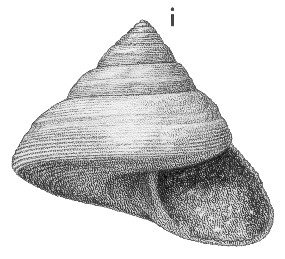
Revised descriptions of New Zealand Cenozoic Mollusca from Beu and Maxwell (1990)

 | Revised descriptions of New Zealand Cenozoic Mollusca from Beu and Maxwell (1990) | 
|
  (Pl. 4i): holotype, GS10191, CH/f104, near Waitangi radio station, Chatham Island, Waipawan (?) (TM4905, GNS) |
Beu & Maxwell (1990): Chapter 6; p. 94; pl. 4 i.
Synonymy: Perotrochus allani Marwick 1928, p. 474
Classification: Pleurotomariidae
Description: Size moderate for genus (height 60 mm), trochiform. Protoconch not known; teleoconch of about 8 whorls, those on spire lightly convex to obtusely angled; last whorl prominently subangled, base lightly convex with a shallow central depression but no true umbilicus. Spiral sculpture of fine threads above selenizone and somewhat coarser ones below, 5 and 8 respectively on penultimate whorl. Adapical spirals on early whorls finely nodulose, otherwise smooth. Base with numerous additional fine spiral lirae becoming obsolete adaxially. Aperture rhomboidal, columella oblique, slightly arcuate, strongly twisted near adapical end. Outer lip with narrow slit near middle, apparently extending back only 0.1 whorl or so of circumference.
Comparison: Pleurotomariids are very rare in the New Zealand Cenozoic, and only two other species have been described to date. Perotrochus marwicki Fleming, 1970 (Altonian, Tarakohe Quarry, Takaka) is larger than P. allani, has a less rounded profile and has more numerous, more prominent spiral cords. Bayerotrochus masoni (Maxwell, 1978) (Duntroonian, Hakataramea Valley) (referred to Bayerotrochus by Maxwell 2009, p. 252) is also much larger than P. allani, is more depressed than P. allani or P. marwicki, and has much weaker basal spiral sculpture. Extant species of Perotrochus (and its relative Entemnotrochus) are eagerly sought-after by collectors; most are from tropical or subtropical regions and from moderately deep waters (typically outer shelf or upper bathyal zones), although two species live in deep water in the New Caledonia- Kermadec Islands area, and one extends as far south as Betty Guyot, Three Kings Rise, off northern New Zealand (Bouchet & Metivier 1982). Knowledge of the diversity and distribution of Recent Pleurotomariidae has increased greatly since 1990.
Distribution: Waipawan, Red Bluff Tuff, sea-cliffs near radio station, Waitangi, Chatham Island (type) (rare); base of Pukekio-Point Weeding section, Chatham Island (rare).
Cite this publication as: "A.G. Beu and J.I. Raine (2009). Revised
descriptions of New Zealand Cenozoic Mollusca from Beu and Maxwell (1990). GNS
Science miscellaneous series no. 27."
© GNS Science, 2009
ISBN
978-0-478-19705-1
ISSN 1177-2441
(Included with a PDF facsimile file
copy of New Zealand Geological Survey Paleontological Bulletin 58 in CD version
from: Publications Officer, GNS Science, P.O. Box 30368 Lower Hutt, New
Zealand)